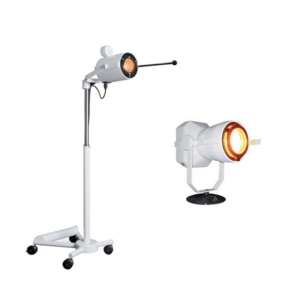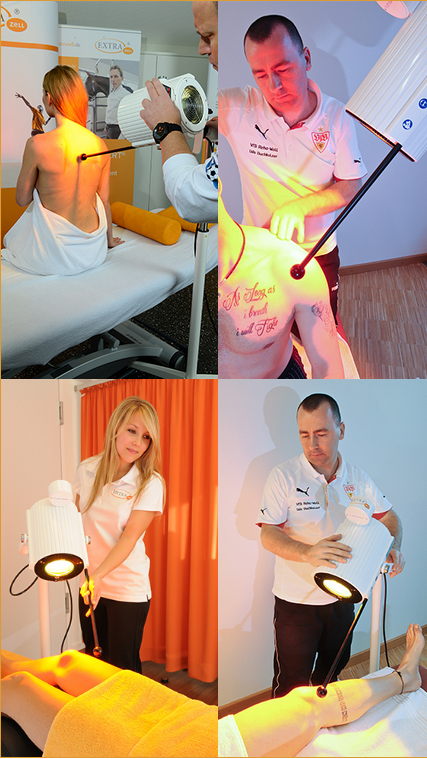Water-Filtered Infrared-A Radiator / wIRA
Innovative medical device for pain treatment therapy, chronic inflammation, poor peripheral circulation, wound healing, oncological hyperthermia.
What is wIRA?
The water-filtered infrared-A-radiation (wIRA) Irradiator allows a locoregional heating of human tissue with a high penetration depth and intensity.
The unique principle of operation involves the use of a hermetically sealed water filter in the radiation path to absorb those infrared wavelengths which would otherwise harm the skin.
This absorption results of the activation of the OH-groups at 940, 1180, and 1380 nanometers. Hence, with the higher radiation intensity, therapeutic heating of deeper tissue layers over longer periods of time can be achieved.
Water-filtered infrared-A light – wIRA
Water-filtered, infrared A (wIRA) is full-spectrum light filtered by a hermetically sealed water filter which filters out all the harmful ultraviolet (UV) light waves.
Only visible and the first band of infrared light, known as infrared A (IR-A), is allowed to pass through the water filter which blocks the unwanted infrared B (IR-B) & infrared C (IR-C) which cause heating and burning
This is similar to and replicates the natrual process of filtering of sun light by upper atmospheric moisture.
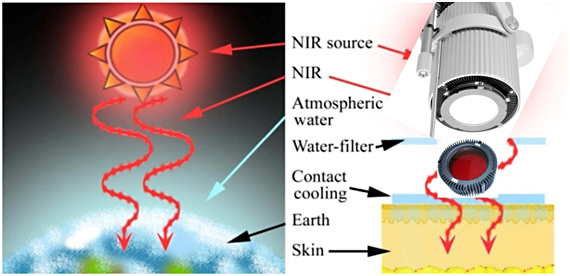

Moisture in the atmosphere filters out harmful UV and far-infrared light waves
The water filter in the wIRA 750 emulates the effects of atmospheric moisture.
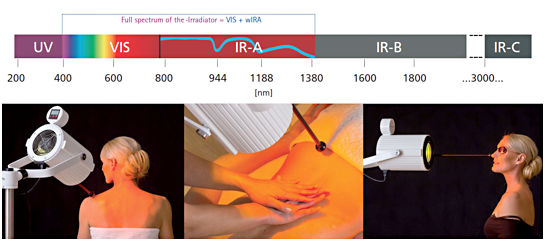

Images above showing treatment of shoulder, lower back and sinusitis.
Spectral differances between wIRA and conventinal infrared lamps / LED lamps
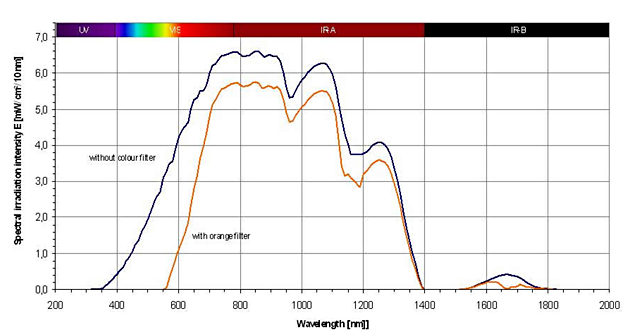

Graph above shows the light spectrum of the wIRA 500 showing the light spectrum difference between water filtered only (blue line) and additional orange lens (orange line). The orange lens filters UV and some visible light.
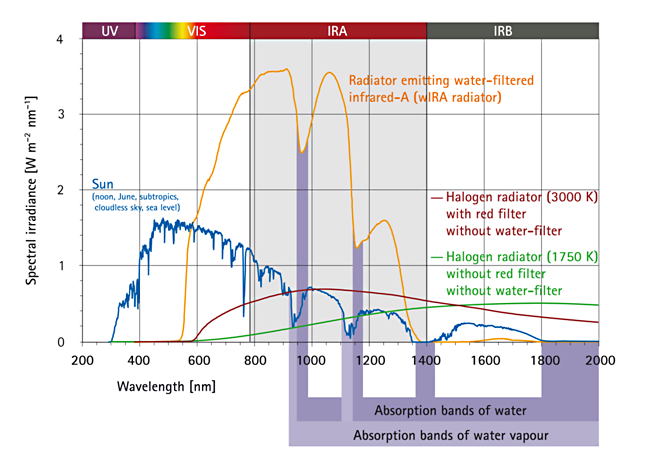

Graph above shows sunlight radiation levels during a European mid-summer sunny day (blue line). The orange line is the spectrum of water filtered infrared A (wIRA). The red line is the spectrum of a 3000 K halogen lamp with an infrared lens but without a water filter from a typical LED infrared lamp. The green line shows the spectrum of a 1750 K low wattage lamp.
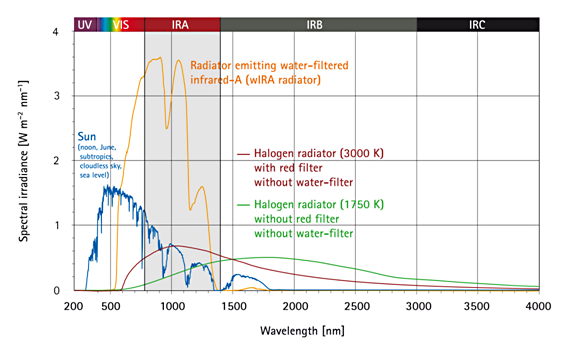

The graph above is the extended view of the previous graph showing infrared C light spectrum (far-infrared). The water filter has filtered out the infra B and C spectrum.
wIRA penetrates deeper and increases the temperature in the deeper layers more effectively than conventional infrared lamps:
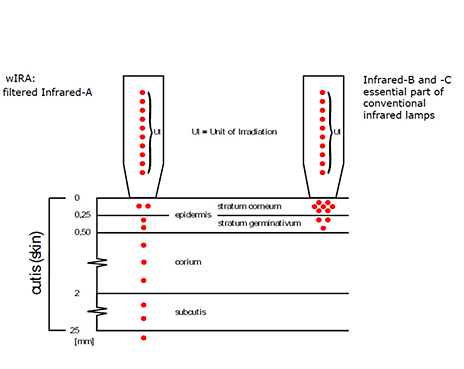

Below a comparison of irradiation with water-filtered infrared-A and conventional infrared
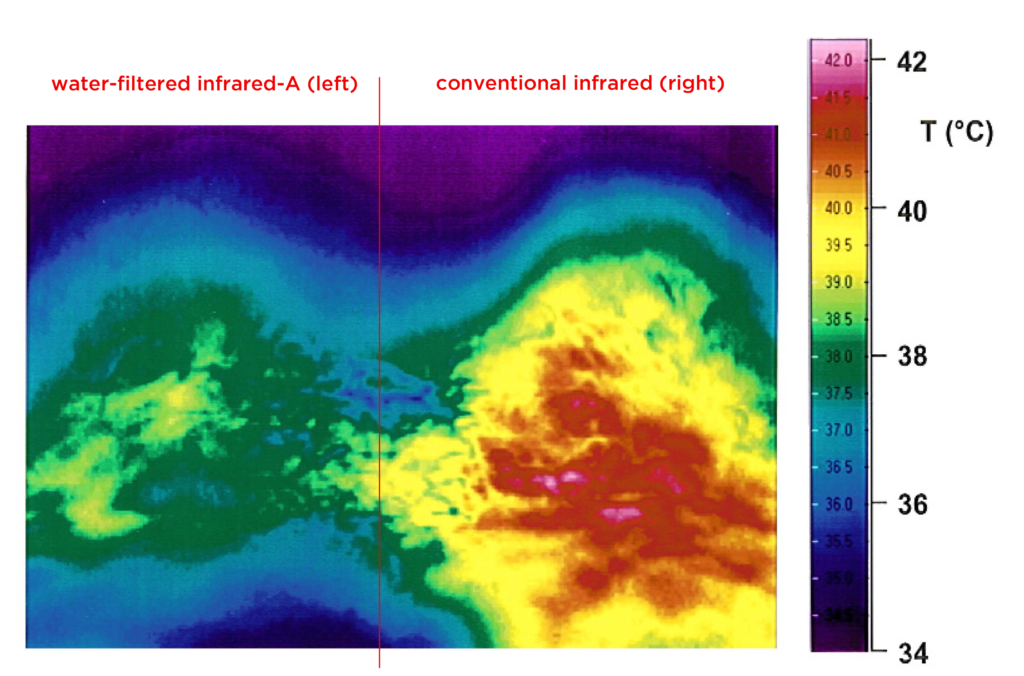

Thermographical comparison of skin surface temperatures in the lumbar region 12 minutes after beginning of irradiation with water-filtered infrared-A (left) and conventional infrared (right) with the same irradiance: the skin surface temperature is higher in case of irradiation with conventional infrared (presented in the thermography), while temperature in 1 cm depth of tissue is higher when irradiating with water-filtered infrared-A. So water-filtered infrared-A presents a high tissue penetration combined with a low thermal load to the skin surface.
Penetration depths corresponding to wavelength of light
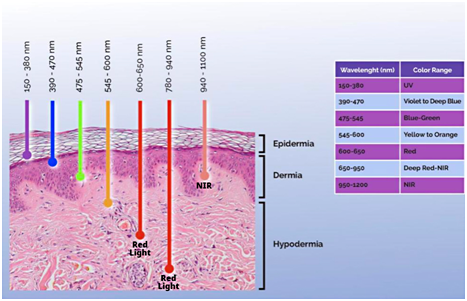

Water-filtered infrared-A (wIRA) in acute and chronic wounds
Water-filtered infrared-A (wIRA), as a special form of heat radiation with a high tissue penetration and a low thermal load to the skin surface, can improve the healing of acute and chronic wounds both by thermal and thermic as well as by non-thermal and non-thermic effects.
wIRA increases tissue temperature (+2.7°C at a tissue depth of 2 cm), tissue, oxygen partial pressure (+32% at a tissue depth of 2 cm) and tissue perfusion. These three factors are decisive for a sufficient supply of tissue with energy and oxygen and consequently also for wound healing and infection defense.
wIRA can considerably alleviate pain (without any exception during 230 irradiations) with substantially less need for analgesics (52–69% less in the groups with wIRA compared to the control groups).
It also diminishes exudation and inflammation and can show positive immunomodulatory effects.
The overall evaluation of the effect of irradiation as well as the wound healing and the cosmetic result (assessed on visual analogue scales) were markedly better in the group with wIRA compared to the control group.
wIRA can advance wound healing (median reduction of wound size of 90% in severely burned children already after 9 days in the group with wIRA compared to 13 days in the control group; on average 18 versus 42 days until complete wound closure in chronic venous stasis ulcers) or improve an impaired wound healing (reaching wound closure and normalization of the thermographic image in otherwise recalcitrant chronic venous stasis ulcers) both in acute and in chronic wounds including infected wounds.
After major abdominal surgery there was a trend in favor of the wIRA group to a lower rate of total wound infections (7% versus 15%) including late infections following discharge from hospital (0% versus 8%) and a trend towards a shorter postoperative hospital stay (9 versus 11 days).
Even the normal wound healing process can be improved. The mentioned effects have been proven in six prospective studies, with most of the effects having an evidence level of Ia/Ib. wIRA represents a valuable therapy option and can generally be recommended for use in the treatment of acute as well as of chronic wounds.
Hoffmann G. Water-filtered infrared-A (wIRA) in acute and chronic wounds.
GMS Krankenhaushyg Interdiszip. 2009;4(2):Doc12.
DOI: 10.3205/dgkh000137
